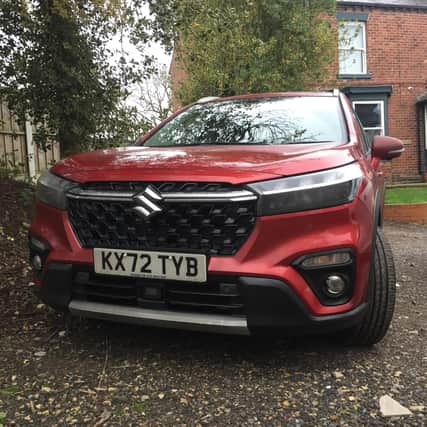Power cuts? No problem with a hybrid Suzuki


Having a car makes a difference and if it is not a pukka battery electric vehicle you need not worry about power cuts and a BEV’s vastly reduced mileage range in cold dark weather, Frederic Manby writes.
Friends who set out on a 50-mile night drive in a modest hatchback with more than 200 miles of electric range returned home in jitters with just 30 miles left.
Advertisement
Hide AdAdvertisement
Hide Ad“What’s the point of them!” spluttered Nick the trucker, along the bar in the Camshaft Arms. Certainly no point in his lorries where the vast weight of batteries would reduce the legal payload. There followed a lament about the price of diesel fuel. I championed self-charging hybrids then drove home in one.
Suzuki has been making mild hybrid cars long before most of us heard about such things. These have a small battery which adds a drop of electric power, enough to improve engine efficiency and response. Now it has a more powerful self-charging hybrid fitted to the Vitara and S-Cross, a pair of SUV wannabes.
The batteries give an ability to run on a light throttle using purely electric clean miles — for example through urban areas. Most of the time the Suzuki, like its peers, alternates or mixes battery and petrol power.
We tried the new S-Cross, which looks larger than before because of its bulkier face and robust styling. Think of a rough pastiche of the Peugeot 3008. This is a popular style of car, usually with better visibility, easy access and some peer approval when you arrive or depart. You can get it with Allgrip 4x4 traction but its ground clearance rules out rough terrain. It may suit you bit there are a baker’s dozen of rivals.
Advertisement
Hide AdAdvertisement
Hide AdModels are Motion and Ultra. The Motion has 17-inch alloys, roof rails, heated front seats, adaptive cruise control, parking bleepers, blind-spot monitors and keyless operation.
Our Ultra had part-leather seats, a long, sliding panoramic sunroof, navigation (sometimes confusing in its routes) and a 360-degree parking camera. This scans the car’s perimeter when you switch on and makes sure you see what’s out of sight of the mirrors. Like my friend’s black cat.
Unlike many full hybrid cars the Suzuki system is not bursting with power. When teamed with the Allgrip selectable 4x4 system and the automatic gearbox the acceleration and economy figures may be disappointing. In fact, the cheaper mild hybrid version is more powerful, faster and has similar economy at a lower price. It is only sold with manual gears which I suspect is a bit of sneaky marketing to get us into the full hybrid. This has Suzuki’s automated manual gearbox, with electronics replacing the clutch pedal. It works well enough, albeit with rather a lot of noise when being hurried along.
Our tests included lots of motorway, where the navigation voice and screen warn of joining traffic from either side. The car control systems rely mainly on using the touchscreen. There is voice control which worked well enough and saves you fiddling with the screen.
Advertisement
Hide AdAdvertisement
Hide AdNice to have old-style knobs and buttons for the heating and ventilation. You also get Suzuki’s white-on-grey instrument dials which are hard to read quickly in some daylight conditions. The full-size rev counter is a waste of space anyway. After dark you’ll notice that the high level brake light illuminates the back window and wiper. This can be irritating.
Despite these caveats and grumbles the S-Cross is pleasant to use. It handles safely and the ride is comfortable. Suzuki fits plenty of passive and active safety systems to protect you inside the car and others on the outside. For example, a rear cross-traffic camera warned me when a pedestrian suddenly walked behind the car.
From 2030, pending a stay of execution, most new cars in the UK will be BEVs. That gives you several years to choose your horse for that decade. The choice is already pushing us towards a battery electric car. Manufacturers are slimming down cheaper models and promoting the glamour of expensive electric cars made affordable to many by tying us into endless rental schemes dependant on having a job. They are filled with luxury kit you can’t delete and which takes power from the precious battery.
There is a half-way house between BEVs and self-charging hybrids. Nissans e-Power has a petrol engine to charge a battery which then drives the wheels. It gives the smooth feel of a BEV with the range of a petrol car and can be zero emission. However, the e-Power petrol engine still produces air pollution when it is charging the battery and it roars when accelerating.
Advertisement
Hide AdAdvertisement
Hide AdA self-charging hybrid will take you over the line and well into the future but petrol may be harder to find.
Suzuki Full Hybrid S-Cross Allgrip Ultra.
It is: Revision of Suzuki’s renowned five-seater estate, with 4WD, six-speed automated manual gearbox, now fitted with its first self-charging hybrid electric petrol engine. Made in Hungary.
Economy: They say 48.7mpg and 132g/km CO2. We got 31mpg on short urban trips; 45mpg on our regular 60-mile mixed route.
Power: 1462cc petrol engine giving 113bhp plus 140 volt motor.
Performance: 0-62mph takes 13.5 seconds.
Length: 169 inches, 4.3 metres.
Advertisement
Hide AdAdvertisement
Hide AdPrices: The Ultra we tested is £31,549 plus £550 for metallic paint (£320 monthly PCP). Motion version 2WD £26,749: Others from £24,999 for the Motion petrol turbo mild hybrid with two-wheel drive, more power, more mpg, more boot space, lower CO2. Fit winter tyres as necessary, my choice.
cars.suzuki.co.uk
Or: The cheaper Vitara, or the larger Qashqai - the UK best-seller.